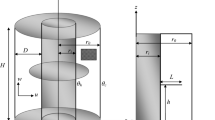Abstract
In this work, the so-called natural or passive ventilation drag reduction method is investigated experimentally and numerically. Passive ventilation is performed by directly connecting the high pressure region at the front of a body to the lower pressure in the near wake using a venting duct; in this manner, a net mass flux is established within the wake. In particular, in aerodynamic applications it appears suitable to attain a global reduction in the drag of a body moving in a fluid and a reduction in turbulence levels by means of a global modification of the body wake. Velocity field investigations using particle image velocimetry measurements and a Reynolds averaged numerical code are employed at moderately high Reynolds numbers to clarify the effectiveness of drag reduction on a vented bluff body. The numerical and experimental results agree qualitatively, but the amount of reduction for the vented body (about 10%) is underestimated numerically. The effectiveness of drag reduction has been proved both for smooth and rough (single strip) models. Direct balance measurements are used for comparisons.














Similar content being viewed by others
References
Achenbach E (1972) Experiments on the flow past spheres at very high Reynolds numbers. J Fluid Mech 54:565–575
Achenbach E (1974) Vortex shedding from spheres. J Fluid Mech 62:209–221
Cummings RM, Giles MB, Shrinivas GN (1996) Analysis of elements of drag in three-dimensional viscous and inviscid flow, AIAA, paper no 962482
Gad El Hak M (2000) Flow control: passive, active, and reactive flow management. Cambridge University Press, Cambridge
Monkewitz PA (1992) Wake control, in bluff body wakes; dynamic and instabilities. In: Iutam symposium, Gottingen
Oertel H Jr (1990) Wakes behind blunt bodies. Annu Rev Fluid Mech 22:539–562
Rae WH, Pope A (1984) Low-speed wind tunnel testing. Wiley Interscience, New York
Roshko A (1961) Experiments on flow past a circular cylinder at very high Reynolds number. J Fluid Mech 10:345–356
Suryanarayana GK, Meier GEA (1985) Effects of ventilation on the flow field around a sphere. Exp Fluids 19:78–88
Suryanarayana GK, Pauer H, Meier GEA (1993) Bluff body drag reduction by passive ventilation. Exp Fluids 16:73–81
Suryanarayana GK, Prabhu A (2000), Effect of natural ventilation on the boundary layer separation and near-wake vortex shedding characteristics of a sphere, Exp Fluids 29:582–591
Author information
Authors and Affiliations
Corresponding author
Rights and permissions
About this article
Cite this article
Falchi, M., Provenzano, G., Pietrogiacomi, D. et al. Experimental and numerical investigation of flow control on bluff bodies by passive ventilation. Exp Fluids 41, 21–33 (2006). https://doi.org/10.1007/s00348-006-0141-x
Received:
Revised:
Accepted:
Published:
Issue Date:
DOI: https://doi.org/10.1007/s00348-006-0141-x




